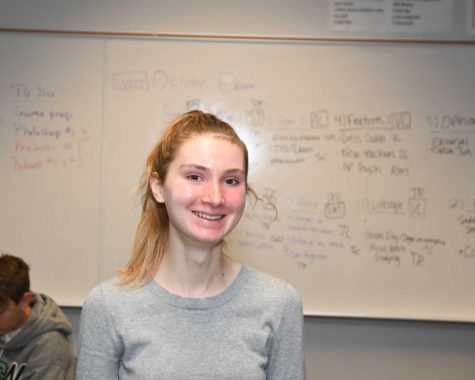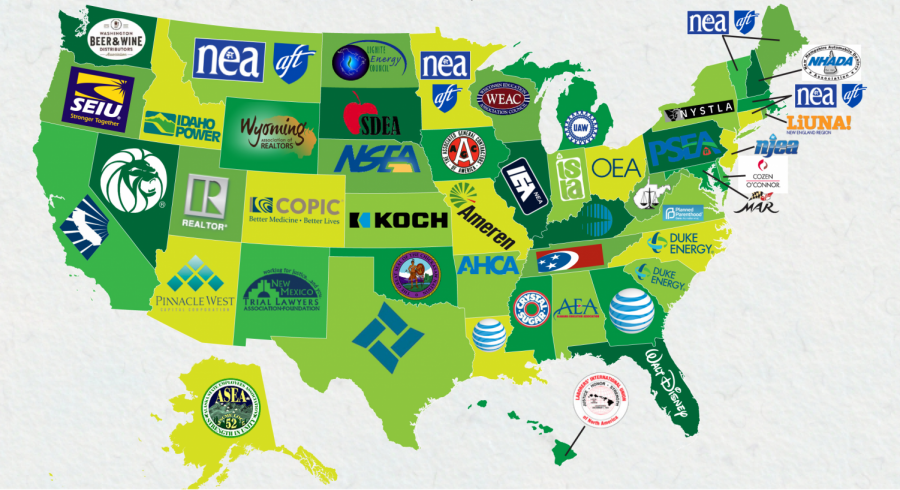Campaign finance controversies complicate civic engagement
The largest donors in each U.S. state are often major corporations or unions.
As the 2020 presidential election cycle edges nearer, solicitations for campaign contributions from various candidates have become almost unavoidable. Between targeted social media advertisements, spam emails from party affiliates, and conspicuous “Donate Now” redirects on candidates’ pages, it’s hard to imagine that most students haven’t at least considered the concept of political donations in the last few months.
At the same time, the amount of students who have spent their own money to donate to a particular policy organization or candidate likely number far fewer. For related reasons—a lack of monetary independence and a lack of voting eligibility—significant political engagement among high schoolers is rare, let alone a desire to spend their limited money on a political campaign.
Even among young people of voting eligibility (ages 18-29), only 9% report ever donating to a political candidate or party, according to a Pew Research poll conducted in 2017. Conversely, 32% of voters aged 65+ report donating to a political organization, campaign, or party.
The correlation between political donations and age stems from the fact that age typically accompanies more financial stability and, once past retirement, an abundance of time with which to be politically involved. For high schoolers and college students voting for the first time, significant transitions and rapidly evolving independence leave little resources to even consider the prospect of spending money on a campaign.
Irrespective of whether young people choose to donate to campaigns, however, individual, small-dollar donations are often portrayed as insignificant compared to multimillion dollar investments by outside donors such as corporations and lobbyist organizations. Students and younger generations tend to particularly focus on the NRA, for instance, as a corrupting influence in the gun-control debate..
“What frustrates me about candidates accepting campaign donations from the NRA is that it almost seems like sometimes candidates don’t feel so strongly about the Second Amendment in the way that they espouse,” senior Ria Debnath said. “They feel pressure to exhibit those ideals solely because they rely on donations from a mega-corporation like the NRA.”
The notion that larger, more influential organizations convince politicians and candidates to act against popular will has lead to increased clamoring for campaign finance reform. Generally speaking, campaign finance reform involves enhanced restrictions on the amount of money individuals, corporations, and outside political organizations can contribute to parties or specific campaigns.
Currently, federal election law prohibits corporations or labor organizations from directly contributing to federal campaigns. Individual donations are also capped at $2,800 per election cycle for a particular federal candidate or party organization. However, corporations and unions may establish Political Action Committees, which can collect from individual donors to raise large sums of cash with which to distribute to candidates or parties (Federal Election Commission).
The NRA, for example, has a PAC called the Political Victory Fund. PACs are subject to federal contribution limits, capped at $5,000 per federal election year. For the 2020 election cycle, the Political Victory Fund has spent $165,100 on direct contributions to candidates’ campaigns—but overall, the NRA’s expenditures total $1.4 million (Open Secrets).
Despite the seemingly restrictive limitations on individuals, PACs, and corporations, federal election law leaves a gaping loophole open for corporations and other unrestricted political organization, known as superPACs, to influence elections. Due to a ruling in the controversial Supreme Court case Citizens United v. FEC, the federal government may not restrict independent expenditures in support of a particular candidate or party.
As a result of the Citizens United ruling, organizations like the NRA, as well as the two major political parties, may spend unlimited amounts of money on political advertising as long as those donations aren’t directly contributed to a particular campaign. Additionally, superPACs may raise money from individual donors and corporations without restrictions, allowing superPACs to subsist solely on mega-dollar donations and avert federal contribution limits by using independent advertisements (FEC).
This major monetary loophole in federal election law helps explain how the NRA and other politically-affiliated organizations manage to invest massive influxes of cash each election cycle in spite of strict contribution limits for PACs and individuals.
Further complicating how campaign contributions are limited, federal contribution limits only apply to federal elections, or presidential and congressional races. For state races, including governor’s races, states determine contribution limits for all organizations and individuals.
“How much freedom individual states have to limit money’s influence in politics is something that I think the Supreme Court is still trying to figure out,” AP U.S. Government and Politics teacher Mr. Flamoe said. “What are the controls of how much financial constraints a state, if they choose to, can place on state campaigns?”
In Oregon especially, campaign finance will be a closely watched issue in 2020. Oregon’s state constitution specifically precludes the state government from obstructing contributions, making it one of five states with absolutely no contribution limits for individuals, corporations, unions, and PACs. The state legislature has placed a constitutional referendum on the 2020 ballot, allowing voters to determine whether they want to open the door to financial limitations in state politics (Portland Tribune).
Given the ever-present loopholes that independent expenditures and superPACs invite, some students question how Oregon’s attempt to equalize the playing field for political donations will actually counter the impact wealthy organizations have in politics.
“If I’m a corporation and I can’t donate money, then I can just go online and create a self-sponsored ad for that candidate with that money,” senior Cole Crystal said. “There’s always going to be workarounds, so then [governments] have to say that you can’t use your money to make any poIitical ads or commentary pieces about a candidate, and then you’re violating free speech. I think it gets a little risky using the argument ‘everyone should be equal,’ because you’re not going to change how the rich and how corporations influence the candidates they want to win.”
Though campaign finance reform remains a major pillar of many 2020 Democratic campaigns, the actual complexities of finding a foolproof way to contain independent expenditures—at least while Citizens United exists—make it more difficult to imagine a path forward for limiting money’s influence in politics.
Mr. Flamoe, however, suggests that the rise of social media and alternative means of advertising offers some optimism for alleviating the need for money in campaigns at all.
“Most people are getting their political information through non-traditional means,” Mr. Flamoe said. “They’re not necessarily going to be seeing political ads on the major news networks. They’re going to be getting those ads in their social media feeds. Now that you can micro-target populations of voters [with social media], it almost seems that if you have really good information, you can have influence on the target population you’re trying to reach without those large sums of cash that were once necessary.”
For civically-minded students feeling disillusioned by the seemingly unstoppable, disproportionate influence of mega-organizations in politics, social media also offers a forum to engage with a campaign without the same inequities that monetary contributions involve.
“I don’t think that one should feel like their financial solvency and their ability to donate to campaigns is the only thing that can legitimize their passion for a candidate,” Debnath said. “There’s other ways to express your support: you can share what [a candidate] says on social media, you can attend campaign events they hold. You can do whatever is within your means to support that candidate. Affluence doesn’t have to be the only deciding factor.”

Shawna Muckle, 17, is a senior at Jesuit High School. She has been a member of the Chronicle staff for three years in various capacities, and she is currently one of its chief editors. Shawna is fascinated by politics and government, and she enjoys writing articles for the Chronicle pertaining to local and national political developments, alongside issues tied to social justice and personal identity. Some of her favorite pieces she’s written include a feature on Jesuit students’ experience with microaggressions, a recap of the 2018 midterm elections, and an article discussing last year’s clerical abuse scandal within the Catholic Church. Outside of journalism, Shawna is the leader of Jesuit’s Model United Nations club and a member of her school’s Ethics Bowl team, which was a 2019 national champion. Shawna is also a Precinct Committee Person for the Washington County Democrats. In her free time, Shawna can be found aggressively running up hills, drinking boba, and yeeting off on road trips to Seattle (for unspecified reasons). Ask her about her opinions on Congress, specifically a) Republicans and b) the crisis with the federal deficit. In the future, Shawna hopes to pursue journalism in college and, later on, as a congressional reporter in DC.




